Physical Address
304 North Cardinal St.
Dorchester Center, MA 02124
Melanoma continues to represent one of the greatest diagnostic challenges in surgical pathology and is an important source of litigation. Both as a primary lesion in the skin and in metastatic sites, this neoplasm is capable of assuming many different macroscopic and histologic appearances that mimic other diseases, both benign and malignant. The four main histologic phenotypes of primary melanoma include (1) superficial spreading (intermittent sun exposure), (2) lentigo maligna (marked sun exposure), (3) acral lentiginous mucosal, and (4) nodular melanoma ( Figs. 7.1–7.4 ). Other morphologic variants include nevoid, spitzoid, balloon (clear) cell, pleomorphic, sarcomatoid, spindle cell/desmoplastic/neuroid, small cell (neuroendocrine-like), signet-ring cell, myxoid, metaplastic, and rhabdoid. All of these variants may be amelanotic, which may make a diagnosis of melanocytic differentiation. This chapter focuses on the use of immunohistochemistry applied to the diagnosis of melanocytic lesions. In addition, we have discussed its use in determining the prognosis and aiding in screening for and evaluating the effect of targeted therapies. Finally, although not specifically an immunohistochemical technique, we included a short description of some of the most relevant and recent ancillary techniques.
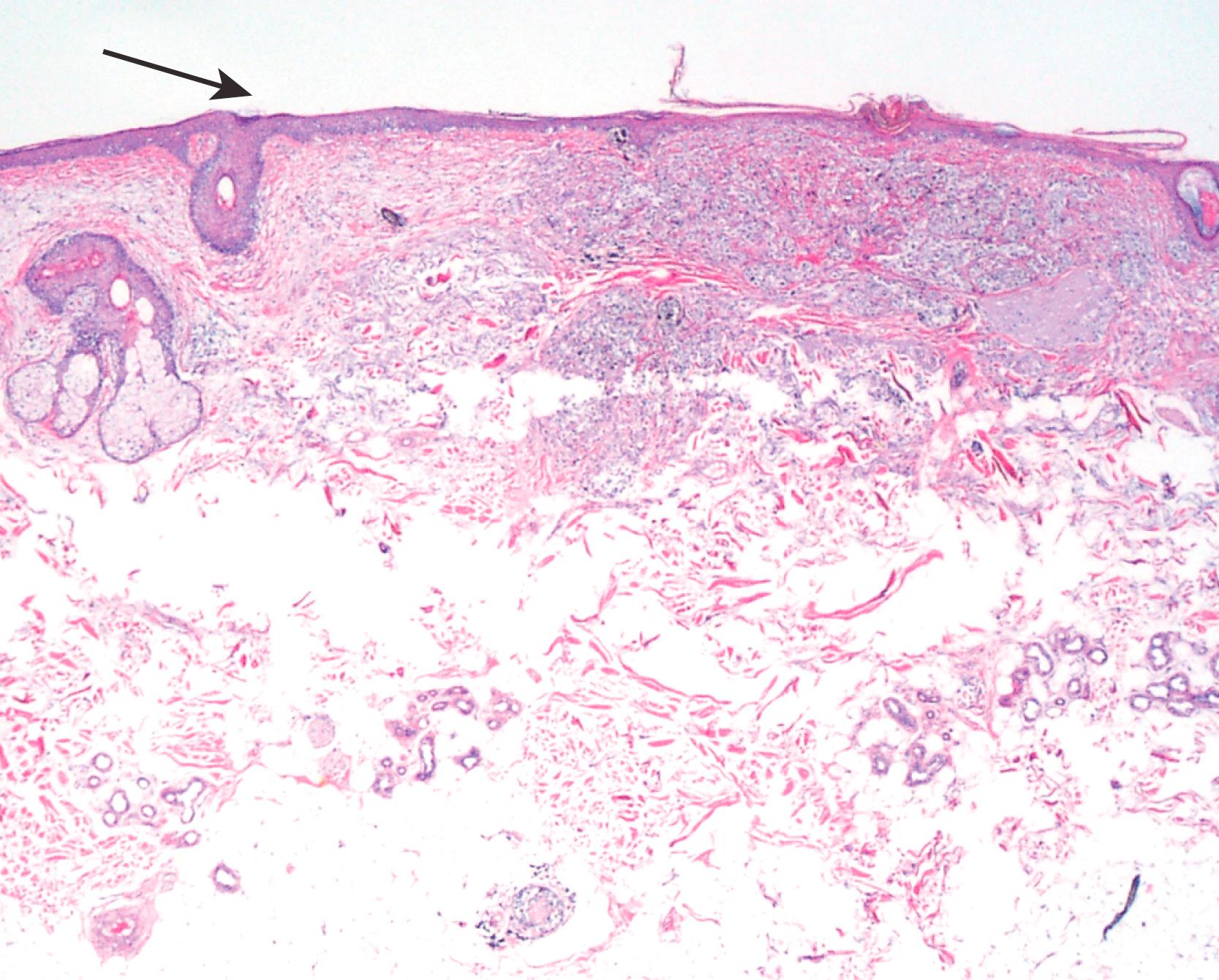
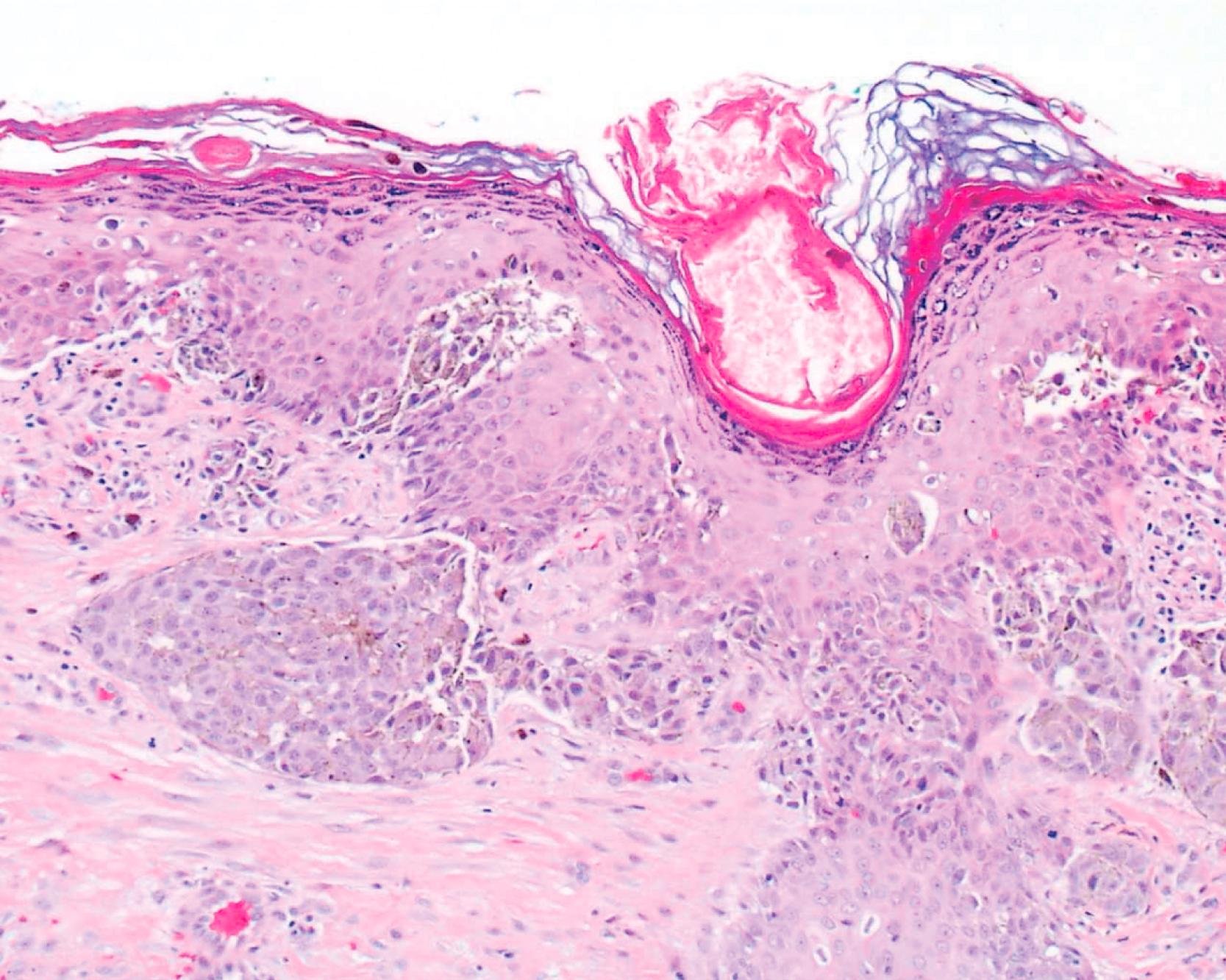
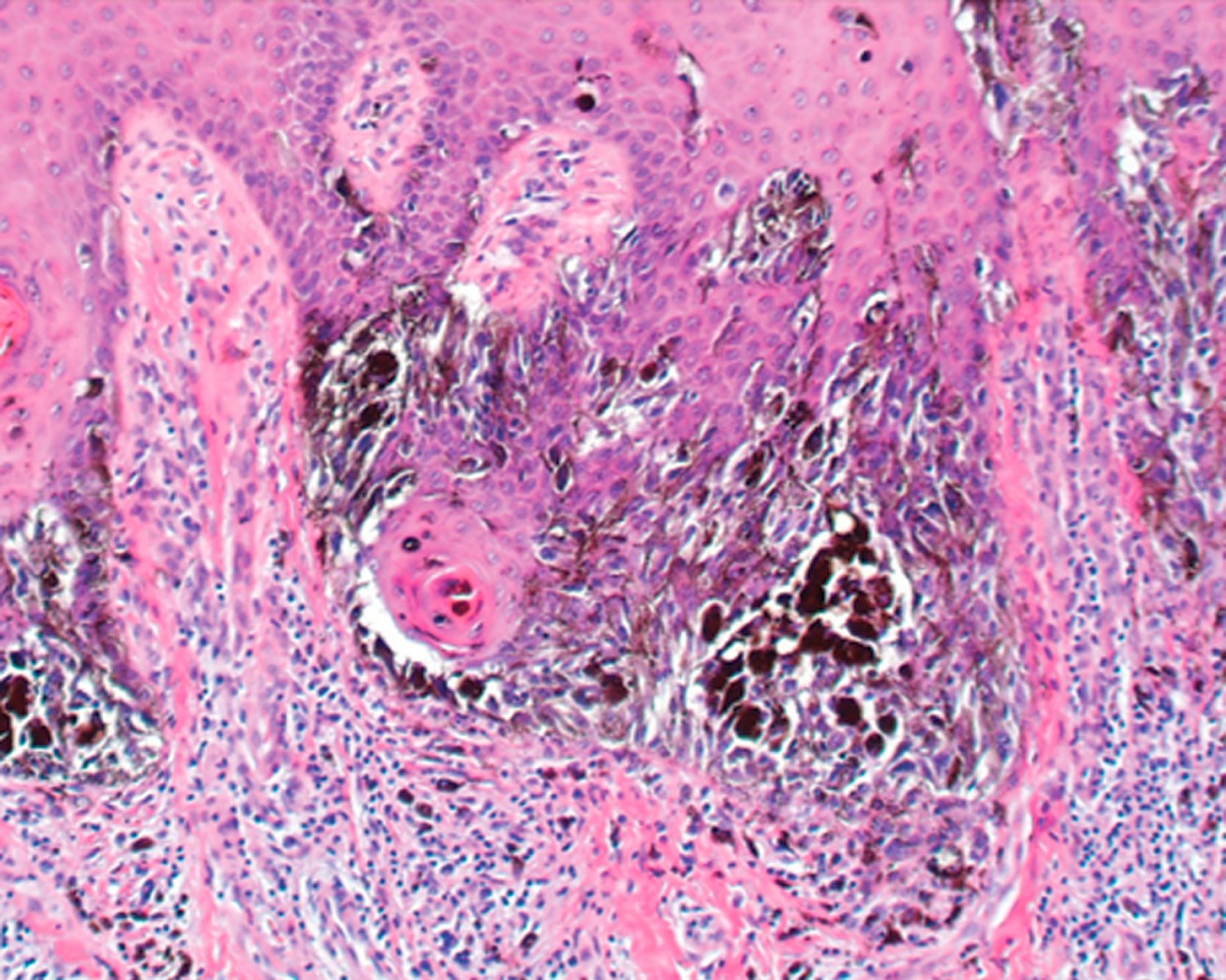
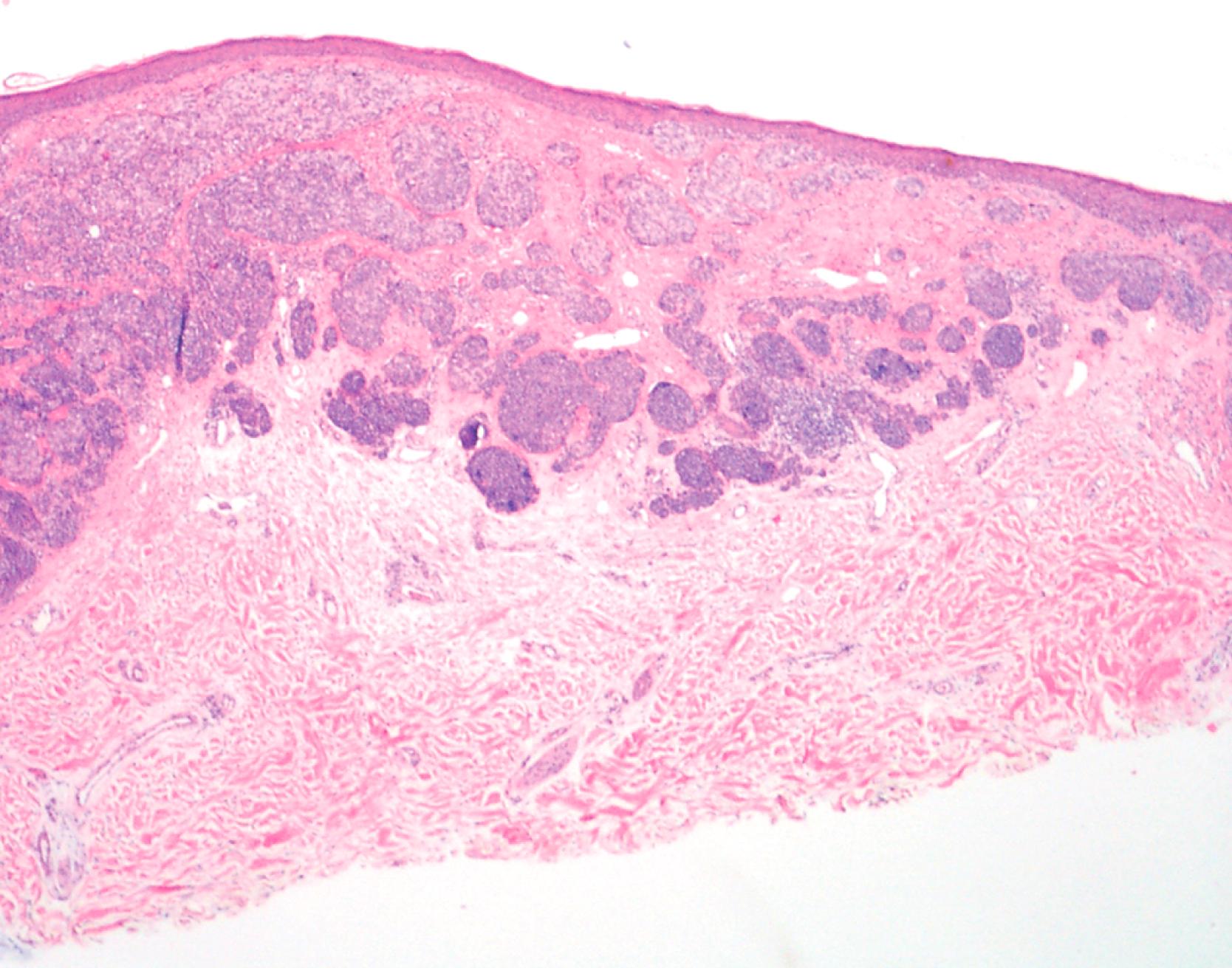
Intermediate filament protein (IFP) analysis has been an important cornerstone of IHC evaluation for nearly 30 years. Use of antibodies against keratins, vimentin, desmin, neurofilament proteins, and glial fibrillary acidic protein (GFAP) can help distinguish between histologically similar classes of neoplasms with dissimilar lineages. , Regarding melanocytic neoplasms, of these IFP, nevi and melanomas typically express only vimentin, and only rarely do they express keratins or the other IFPs ( Fig. 7.5 ). Moreover, the density of vimentin in melanogenic tumors is high and yields intense immunoreactivity for that marker in most instances. Due to the widespread expression of vimentin by most mammalian cells, some authors have suggested to use it to determine whether the tissue antigenicity is appropriately preserved. However, in our opinion, the majority of antibodies used in the skin have already built in internal controls (e.g., Langerhans and intraepidermal and intra-adnexal melanocytes express S100; those same melanocytes express MART1, SOX10, and MITF; sebaceous cells and perineural cells express epithelial membrane antigen [EMA]), and therefore there is no appreciable need for the use of vimentin as a control of adequacy in immunohistochemical studies of the skin. GFAP and desmin have been reported in a small minority (<1%) of melanomas, usually tumors that demonstrate “metaplastic” sarcomatoid microscopic features or, conversely, desmoplastic and neuroid characteristics. For practical purposes, and in specific reference to studies on paraffin sections for these IFPs, more than 95% of melanocytic neoplasms are labeled solely for vimentin or S100 (see also later) even after application of techniques such as heat-mediated epitope retrieval.
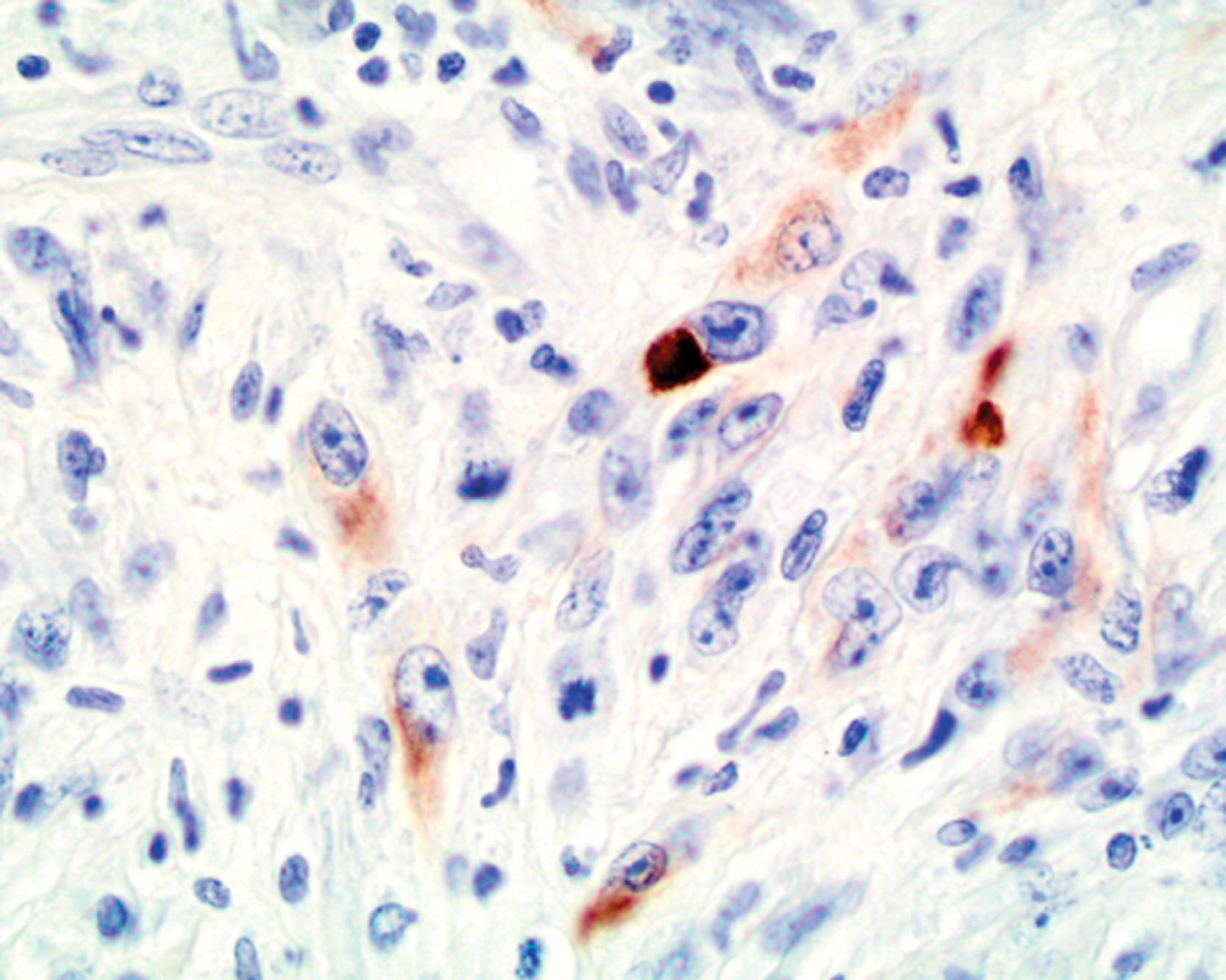
Muscle-specific actin, recognized by monoclonal antibody HHF-35; α-isoform, or smooth muscle actin (SMA), recognized by antibody 1A4; and caldesmon are also preferentially seen in non-epithelial, non-melanocytic, non-glial tissues. They are rarely detected in melanocytic lesions but can be seen in spindle cell melanomas that show myofibroblastic differentiation.
A diversity of proteins associated with cell membranes come into play in relationship to the differential diagnosis of melanoma. These fall into two broad categories: those associated with epithelial cells and those that relate to hematopoietic elements.
EMA, a family of glycoproteins related to the milk fat globule proteins, is expressed by a variety of epithelia and their neoplasms. The principal exceptions in the latter group include germ cell tumors, adrenocortical proliferations, and hepatocellular neoplasms. , An EMA-like moiety may also be observed in selected lymphoid and plasmacellular tumors. , Melanocytic proliferations are rarely reactive for this marker ( Fig. 7.6 ). It may be observed within foci of melanomas that border zones of geographic necrosis, but those areas should likely be considered as artifactual. Another possible pitfall is the observation of EMA expression in plasma cells, which are present in a number of melanomas and may be misinterpreted to be positive melanoma cells.
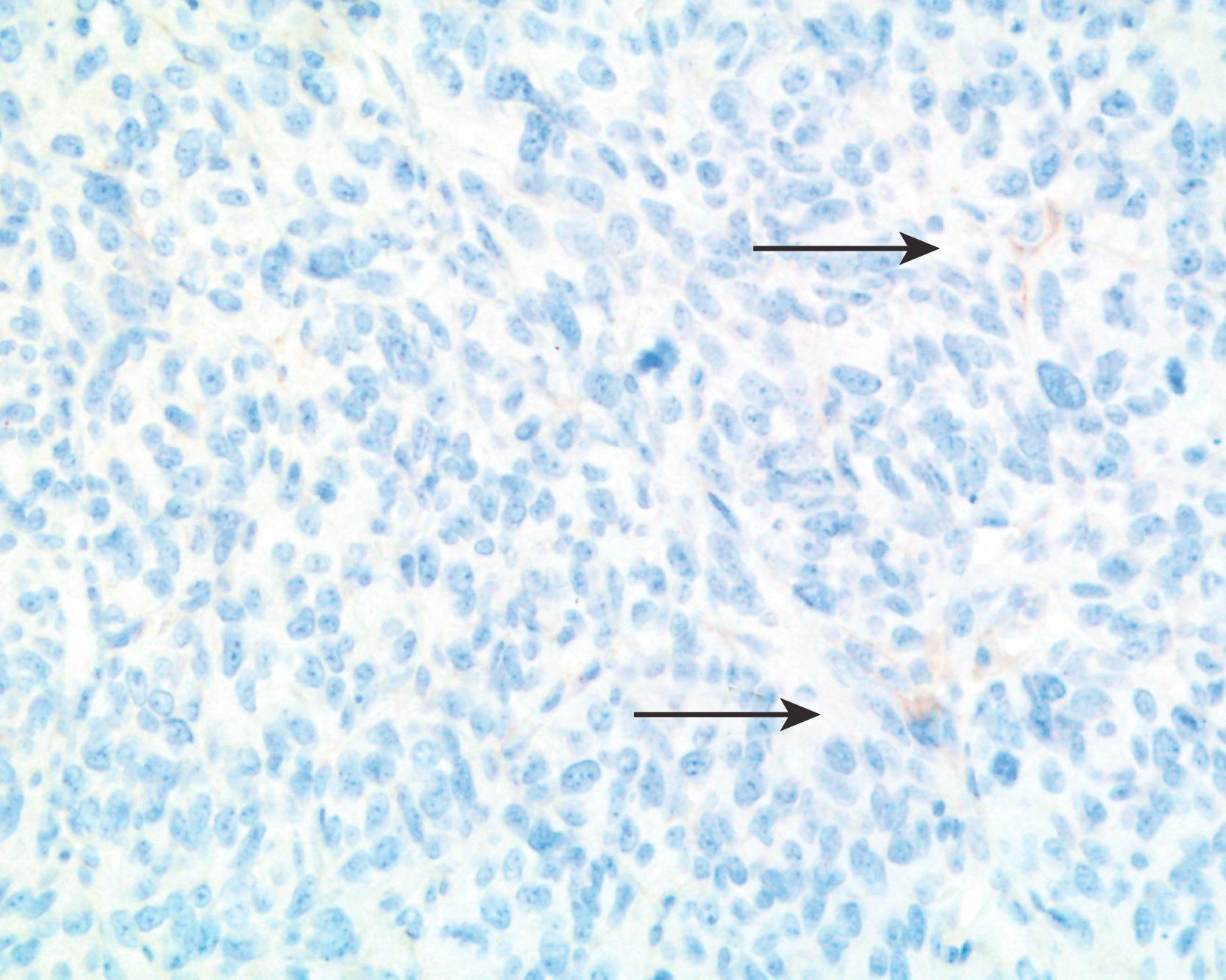
Carcinoembryonic antigen (CEA) characterizes a family of glycoproteinaceous cell membrane constituents present mainly in tissues and neoplasms with endodermal differentiation. In the past, it has been contended that CEA may be observed in melanomas, but this observation is considered to be artifactual. Polyclonal anti-CEA recognizes several proteins other than CEA (e.g., nonspecific cross-reacting antigen, biliary glycoprotein), many of which are not restricted to epithelial cells. If monoclonal antibodies are used with suitable specificity to restricted CEA epitopes, melanocytic neoplasms should be negative.
Tumor-associated glycoprotein-72 (TAG-72/CA72-4, recognized by monoclonal antibody B72.3), BER-EP4, and MOC-31 are all cell-membrane glycoproteins most consistently synthesized by epithelial cells. Rare exceptions to this do exist, however, such as TAG-72 presence in some epithelioid vascular tumors, but melanocytic neoplasms should be negative for these three glycoproteins. Therefore, IHC studies against this group of adjunctive epithelial markers are useful to others for keratin, EMA, and CEA in helping to exclude epithelial neoplasms when considering the differential diagnosis of melanoma. It can safely be stated that virtually all somatic carcinomas should be reactive for at least one of the membrane determinants cited earlier in this discussion, in addition to keratin, in contrast to those rare melanomas that focally express keratin but lack the other markers.
Placental alkaline phosphatase (PLAP) is an isozyme commonly synthesized by neoplastic germ cells and certain somatic epithelial malignancies. As such, it is a useful screening marker for gonadal tumors such as seminoma, embryonal carcinoma, and yolk sac carcinoma, all of which may enter the differential diagnosis of melanoma. In contrast, melanocytic proliferations are consistently negative for PLAP, although we have encountered a melanoma lesion with focal PLAP expression.
Selected cell-surface antigens typically associated with hematopoietic cells and neoplasms also are potentially seen in melanocytic cells and neoplasms. Among others, these include CD10, CD44, CD56, CD57, CD59, CD68, CD74, CD99, CD117 (C-KIT protein), CD146, class II major histocompatibility antigens (MHC2As; human leukocyte antigen [HLA]-DR, HLA-DP, and HLA-DQ), β-2-microglobulin (B2M), and Bcl - 2 protein. These markers may be seen in some examples of Spitz nevus (epithelioid and spindle cell), architecturally disordered (dysplastic) nevus, and melanoma. Particularly interesting is the expression of CD10 by some melanocytic lesions because this marker is commonly expressed in atypical fibroxanthoma, a lesion in the differential diagnosis with spindle cell melanoma. Conversely, melanocytes uniformly lack other hematopoietic determinants that may enter into differential diagnostic evaluations of melanoma, such as terminal deoxynucleotidyl transferase (TdT), factor XIIIa, myeloperoxidase, and CD15, CD20, CD21, CD23, CD30, CD35, CD43, CD45, and CD138. ,
The expression of MHC2A proteins and B2M by melanocytic proliferations appears to be a property confined to inflamed intradermal or architecturally disordered nevi and occasional melanomas. Interestingly, mucosal melanomas (MMs) that escape immune surveillance have been noted to downregulate their expression of B2M and histocompatibility antigens over time through mutations in the corresponding gene complexes and other mechanisms. Because of the immunophenotypic heterogeneity seen in melanocytic lesions (as well as other tumors) for MHC2A and B2M, such determinants should not be used to distinguish or rule out a melanocytic lesion.
The ability of melanomas to express Bcl-2 protein and CD10, CD68, CD56, CD57, CD99, and CD117 creates a possible diagnostic pitfall in that such markers may lead clinicians to interpret these as lymphomas, histiocytic lesions, primitive neuroectodermal or neuroendocrine neoplasms, and gastrointestinal stromal tumors. As usual, the application of carefully constructed panels of antibody reagents, tailored to specific diagnostic scenarios, should preclude those mistakes. A recent study (28511749 Microinvasive Radial Growth Phase of Cutaneous Melanoma: A Histopathological and Immunohistochemical Study with Diagnostic Implications) has reported that CD117 expression (along with Cyclin D1 and E Cadherin, see also below) decreases when melanoma cells invade the dermis.
NB84 is a monoclonal antibody raised against a cell-membrane determinant found in neuroblastomas. It is active in paraffin sections and labels, not only neuroblastic neoplasms, but also a subset of primitive neuroectodermal tumors (PNETs). Melanocytic proliferations are nonreactive with this reagent, a fact helpful when the differential diagnosis centers around small cell melanoma versus a neuroblastic or neuroectodermal tumor arising in a large congenital nevus or neurocristic hamartoma.
Several proteins that affect intracellular calcium metabolism can be seen in melanocytic proliferations, including Annexins V and VI, Cap G, calmodulin, calretinin, and S100 protein. The most important ones for the differential diagnosis are discussed further in the next section.
One of the first and most important markers for melanoma is S100 protein. This 21-kDa moiety was first detected in glial cells of the central nervous system (CNS), and it was named because of its solubility in 100% saturated ammonium sulfate solution. In 1981, Gaynor and colleagues recognized the fact that S100 protein was also present in human melanoma cells, leading to its widespread application as a diagnostic indicator ( Fig. 7.7 ).
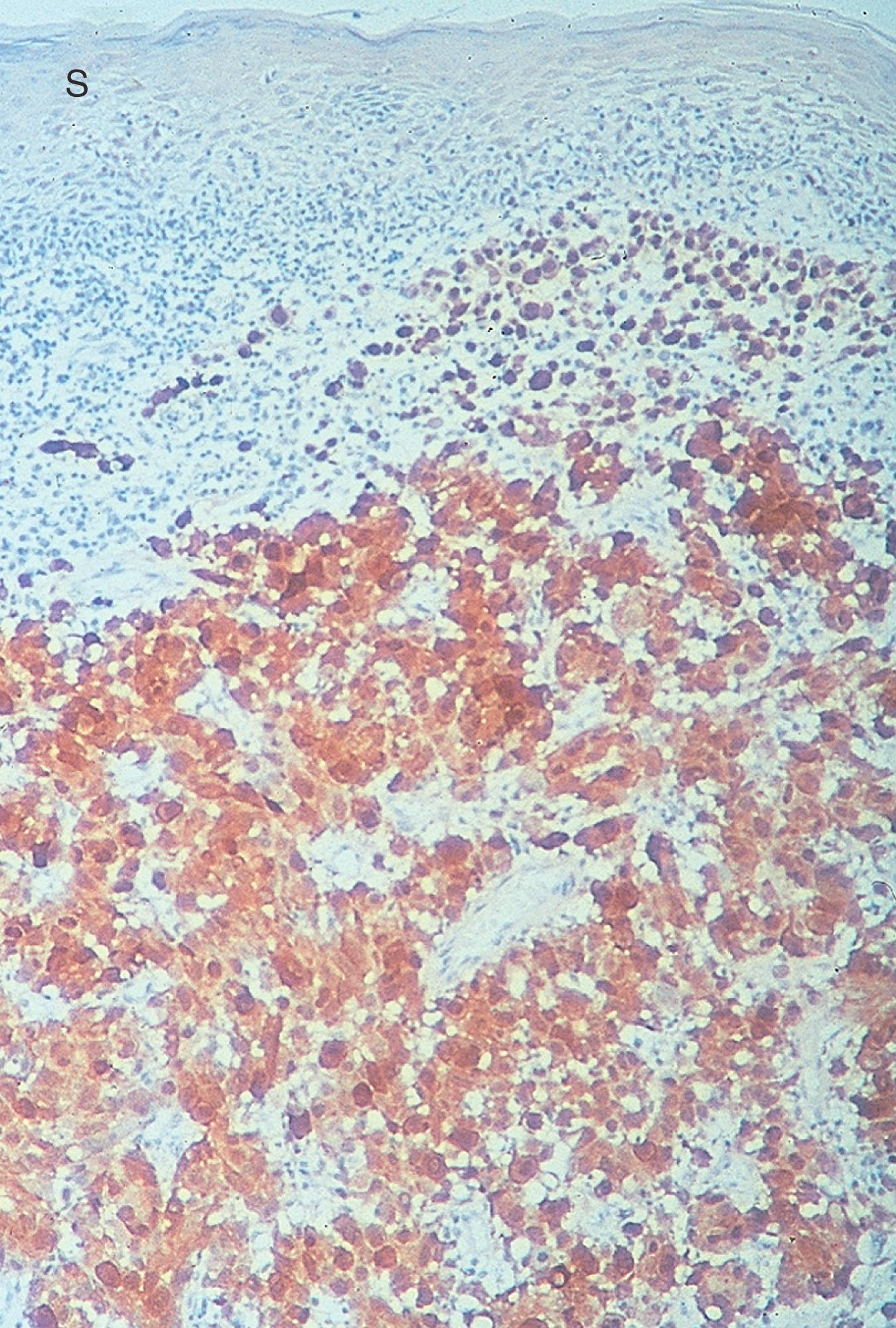
The function of S100 has not been determined with precision; however, it is thought to function in intracellular calcium trafficking or microtubular assembly or both. , It has a loose physiologic relationship to calmodulin, another calcium flux protein. Two subunits to S100, α and β, yield three possible dimeric forms: α-α, α-β, and β-β. Melanocytes synthesize only the first of those combinations. Immunoreactivity for S100 protein is both nuclear and cytoplasmic. Immunoelectron microscopic studies have confirmed that this marker is present in both intracellular compartments in normal and neoplastic melanocytes.
There are many antibodies against S100, some of which are dimer-specific monoclonal products. In general practice, most clinical laboratories still use heteroantisera that recognize all three isotypes of the protein against this marker, yielding a high-sensitivity screening tool. In this context, the author’s experience has been that more than 98% of melanomas can be labeled for S100 at least focally, regardless of histologic subtype, as long as the tissue is properly preserved (see below).
Smoller also reported a similar experience with S100 protein (97.4%). Other S100 protein–positive tumor types that enter into differential diagnosis include various carcinomas (e.g., breast carcinomas), selected histiocytic proliferations, gliomas, peripheral nerve sheath tumors (PNSTs), and Langerhans histiocytosis. , It is obvious that S100 is most valuable in this setting as an initial screening reagent for melanocytic tumors rather than as a specific marker for such neoplasms.
Various isoforms of S100 protein (A2, A6, A8/A9, and A12) have also been considered diagnostically regarding various melanocytic lesions. Ribe and McNutt suggested that S100A6 was differentially expressed by Spitz nevi and melanomas. All Spitz tumors were A6 reactive, whereas only 33% of melanomas showed positivity. Moreover, differences in the scope of labeling were observed, with Spitz nevi being globally A6 reactive; in contrast, melanomas showed weak and patchy staining. Another possible application for this monoclonal marker (S100A6) is secondary to its expression in cellular neurothekeomas.
Possible pitfalls are related to S100 protein expression. The antibody S100 protein in formalin-fixed tissue may not work on frozen sections, alcohol-fixed tissue, or on formalin-fixed paraffin-embedded (FFPE) sections of previously frozen tissue. Furthermore, if the tissue is overfixed or underfixed, S100 expression may be impaired ( Fig 7.8 ). At our institution, to optimize S100 (and other antigens) detection, we require for skin biopsies to be fixed in a manner similar to breast biopsies. The protocol requires at least 6 hours fixation in formalin for a maximum of 48 hours. As another pitfall, it has been suggested that S100 expression may be decreased in sun-damaged melanocytes.
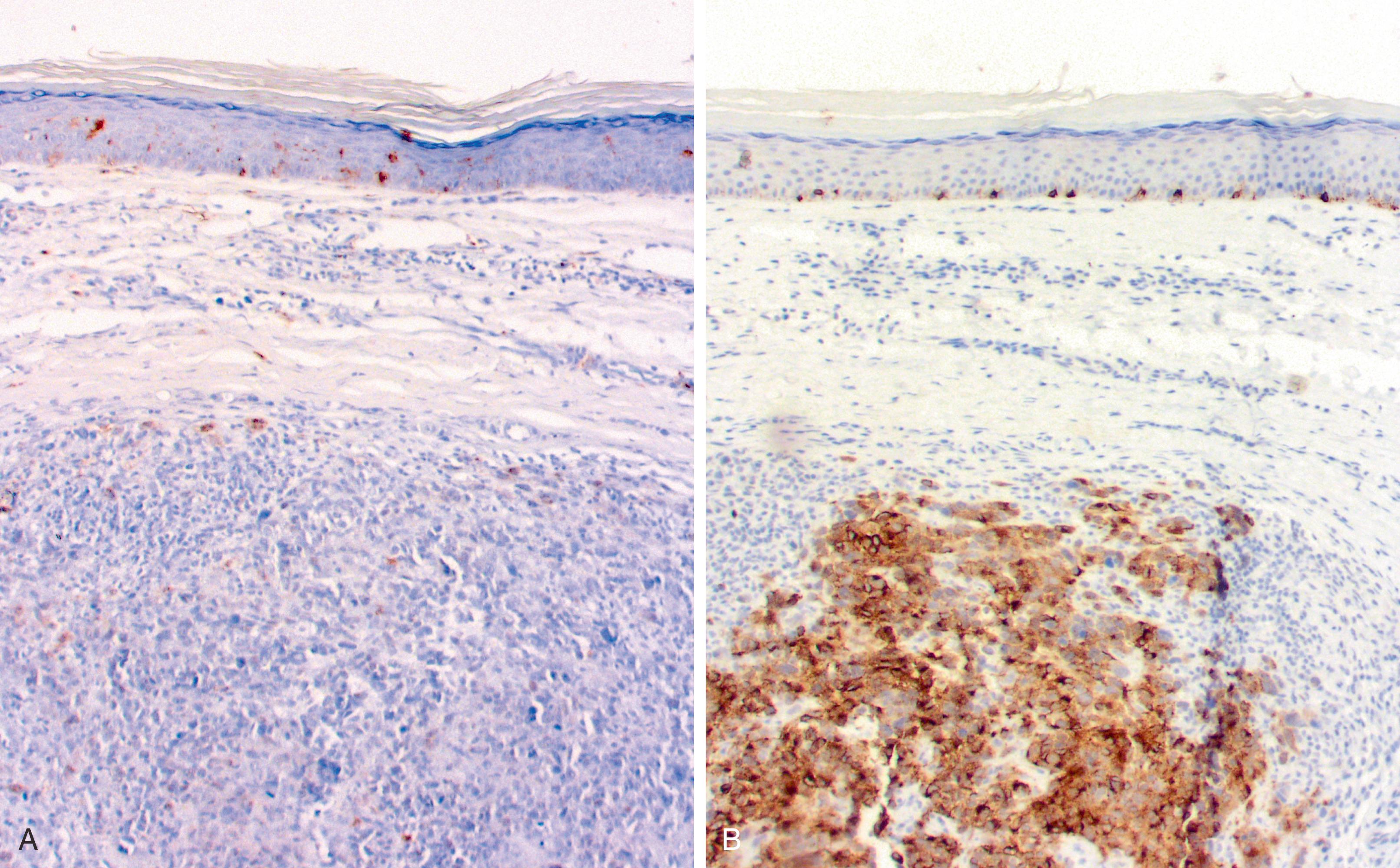
Calretinin is a cytoplasmic 31-kDa protein first isolated from CNS tissues. It is also seen in peripheral nerves in the skin and elsewhere. Otherwise, this polypeptide is rather restricted in distribution, having been detected thus far only in mesothelium, germinal-surface epithelium of the ovary, and certain adenocarcinomas, most notably a subset in the colon, rectum, and skin. Also in the skin, some of the cells in the adnexa (eccrine and apocrine) may express this marker. Melanocytic tumors are not included in the list of neoplasms that show potential calretinin immunoreactivity.
Become a Clinical Tree membership for Full access and enjoy Unlimited articles
If you are a member. Log in here